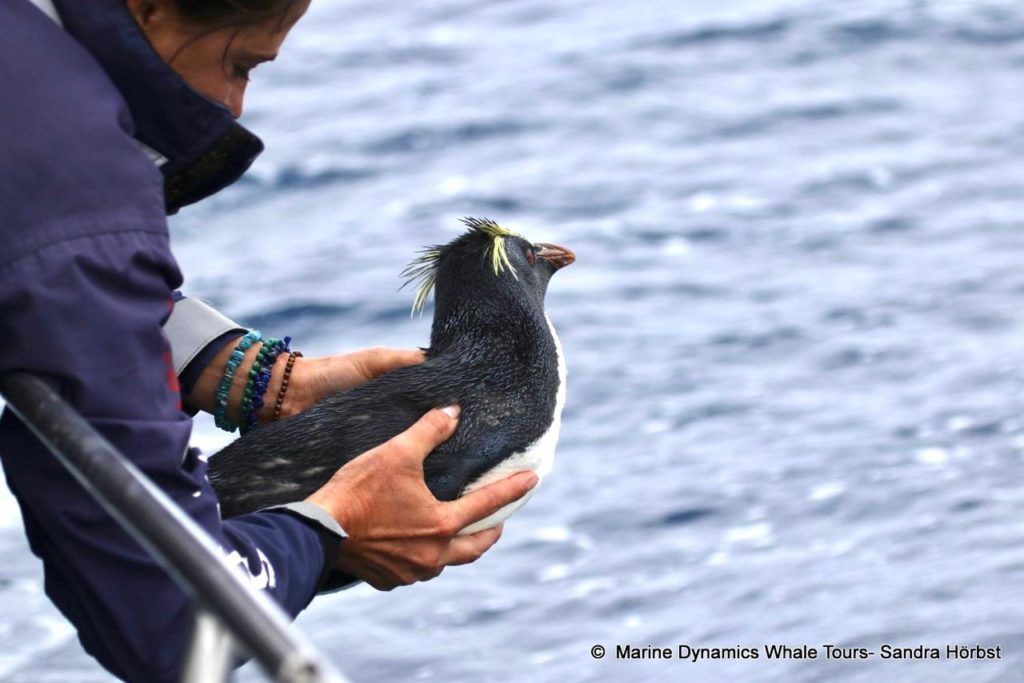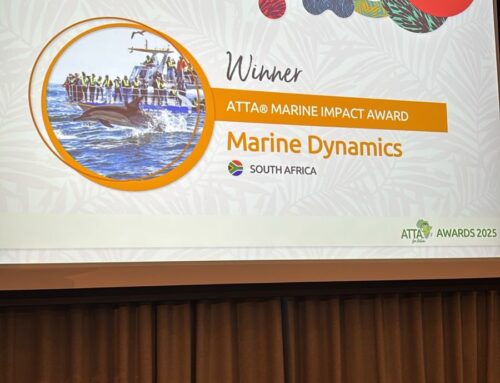On Wednesday, December 4th, the Dyer Island Conservation Trust, powered by Marine Dynamics, undertook an extraordinary six-hour, 180-kilometer expedition to release a Rockhopper penguin back into the Agulhas Current.
Earlier this year, the penguin had stranded on our shores, underweight and bearing a few wounds. It was admitted to the African Penguin & Seabird Sanctuary (APSS) for treatment, rest, and recovery. After weeks of dedicated care, the Rockhopper, healed completely, underwent a successful molt, and emerged with a pristine set of feathers. Following comprehensive health checks by APSS veterinarian Dr. Annamarie Robberts, Rocky was cleared for release and ready to return to the vast ocean.
The Agulhas Current, flowing south-westward along South Africa’s east and south coasts, acts as a natural conveyor belt. The warm fast flowing waters offered Rocky a swift and smooth path on the long journey home.

A Rare Encounter with Pelagic Birds
The journey wasn’t just about releasing Rocky—it also provided a rare opportunity to observe some of the ocean’s most remarkable pelagic bird species up close.
Here’s what graced our birdwatching list for the day:
- Cape Gannet: These stunning Southern African endemics, with their white bodies, yellow-tinged heads, and black wingtips, never fail to delight.

- European Storm Petrel: A diminutive 20-gram marvel, these birds breed on rocky northern European islands and winter in the South Atlantic. They’re recognized by their fluttery flight near the water’s surface and distinctive snow-white rumps
- Great Shearwater: With its brown upper plumage, white underparts, and vast Atlantic range, this seabird breeds on remote islands like Gough and Tristan da Cunha—2,600 kilometers from Gansbaai.

- Manx Shearwater: A smaller, darker cousin of the Great Shearwater, this bird’s “shearing” flight style involves skimming waves with minimal wingbeats.
- Cory’s Shearwater: A summer migrant with brownish-grey upper parts and a yellowish bill, Cory’s Shearwater breeds on islands like Madeira and the Azores before dispersing across the Atlantic.
- Sooty Shearwater: Recognized by its chocolate-brown plumage and slender wings, this species undertakes a circular migration, covering vast distances annually.

- Subantarctic Skua: A robust predator spotted near a longliner.
- Arctic Skua: A seasonal visitor from the Arctic tundra, these notorious “pirates of the sea” are infamous for stealing fish mid-air from other birds.
- White-chinned Petrel: Common in the area, this large petrel is easily identified by its ivory-colored bill and the tiny white patch under its chin.

A Trio of Albatrosses
The highlight of the trip was undoubtedly spotting three species of majestic albatrosses:
- Shy Albatross: Distinguished by its pale underwings edged in black, this species breeds near Tasmania and New Zealand but frequents South African waters during winter.

2. Black-browed Albatross: With its orange-yellow bill and striking black underwing markings, this bird amazed us as it glided effortlessly above the waves. Most of its breeding population resides on the Falkland Islands.

3. Atlantic Yellow-nosed Albatross: A classic black-and-white mollymawk with a distinctive black smudge near its eye, it breeds on Gough and Tristan da Cunha.
Witnessing these albatrosses soar gracefully above the waves, knowing they had traversed thousands of kilometres to visit our oceans, was nothing short of magical.
Into the Deep Blue
For me, this was my first venture into the open ocean. I saw the inky purple-blue hues marking the edge of nowhere, where the seabed plunges from 400 meters to a staggering 1,500 meters. I felt the touch of the warm Agulhas current. These are moments that will be with me forever.
Seeing towering container ships traverse this blue highway and encountering longliners along the route was a sobering reminder of our responsibility to conserve this incredible seascape.
“People ask: Why should I care about the ocean? Because the ocean is the cornerstone of Earth’s life support system. It shapes climate and weather. It holds most of life on Earth. Ninety-seven percent of Earth’s water is there. It’s the blue heart of the planet—we should take care of our heart. It’s what makes life possible for us. We still have a really good chance to make things better. They won’t get better unless we take action and inspire others to do the same. No one is without power. Everybody has the capacity to do something.”
— Sylvia A. Earle
Acknowledgments
A heartfelt thanks to Marine Biologist and bird enthusiast Sandra Horbst for her invaluable expertise in identifying and sharing insights- and pictures, about the incredible pelagic birds we encountered. After three years at Marine Dynamics, I can finally distinguish between a gull and an albatross—success! Thank you, Sandra.
Christine Wessels





